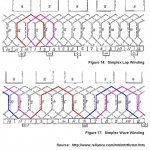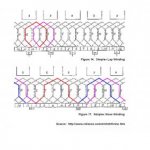Had another look at resistances with a calibrated Fluke meter...... Basically no difference.
The armature readings are confusing. Seem to vary between 1 and closer to 10 ohms as you rotate it. And I am still confused as to why I cannot find any open circuits between any of the commutator contacts.
I apologize. It’s been a long time since I looked at how armatures are wound and I’ve apparently forgotten most of what I knew. (Thanks to Bill W for helping me out here).
There are two basic types of armature windings, lap and wave. This tutorial by Reliance goes into it in some detail:
Reliance.com - Basic Motor Theory
Here’s two diagrams from the tutorial that I’ve color coded to make it easier to see how the windings are connected in lap and wave wound armatures:

In a lap wound armature each coil is connected to adjacent commutator bars. As you proceed around the armature all of the coils are connected in series. In figure 14 note the a coil connects from commutator bar 1 to bar 2; the next coil connects from 2 to 3 and so forth until 12 connects back to one, completing the ring. If you check adjacent bars you should find the same resistance between each pair and it will be a fairly low resistance. If you checked between bars 180 degrees apart you would see a much higher resistance. If a there were an open coil in the armature the resistance between adjacent bars would be much higher that normal.
A wave wound armature has coils that connect directly to the opposing commutator bar (about 180 degrees for one pair of brushes, about 90 degrees for two pairs of brushes, etc.). In figure 17 you can see how the red coil connects from bar 1 to 6. If you follow the circuit around you will find the following connections: 6 to 11; 11 to 5; 5 to 10; 10 to 4; 4 to 9; 9 to 3; 3 to 8; 8 to 2; 2 to 7; and finally 7 connects back to 1. Again all of the coils are connected in series. If you check adjacent commutator bars you will find a fairly high resistance. Since there are an odd number of bars there isn’t a bar at exactly 180 degrees, but the two bars on either side of the split 180 degrees from a given bar are connected by coils; for example, bar 6 is directly opposite the split between bars 1 and 11. Bar 6 connects to bar 1 via the red coil and bar 11 via the blue coil. So you should find a low resistance between a given bar and the two bars on the opposite side of the commutator (if the machine had two sets of brushes you would be looking at 90 degrees).
I think that there’s an error in the tutorial’s version of Figure 17 relating to the brushes. I’ve corrected it in my drawing. Note that in the brush position shown the red and blue coils receive power at the same time, but in opposite polarity.
There lots of variations on the two basic winding schemes and I’m far from an expert. But hopefully the above will help us understand your readings.
Here are a few more links that discuss DC armature winding:
Unfortunately, my machine is sitting in a corner and I don’t have access to check the commutator resistance on my generator. I'll have to leave it to you to figure out what sort of winding we're dealing with.
Checking the exciter’s armature will be similar to that of the generator, although it’s very possible that it’s wound differently. I’m very interested to see what you come up with. You should probably remove the brushes when you’re checking the bar to bar resistances, since the brushes will be shorting out at least on pair of bars.
How many commutator bars do the generator and exciter have?
Cal


